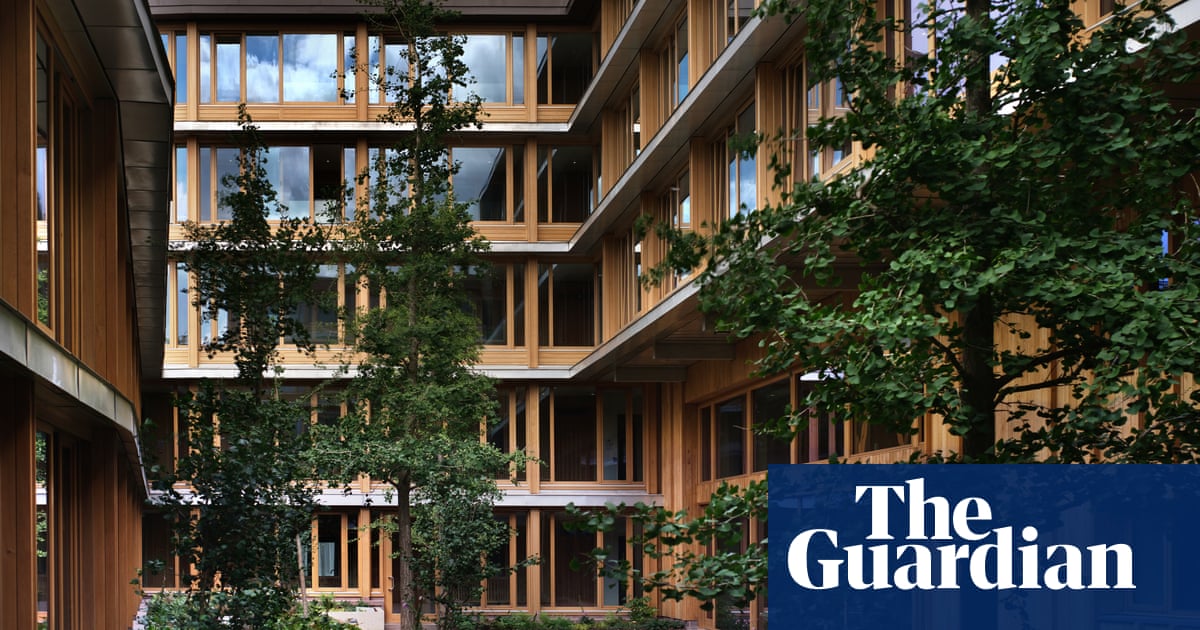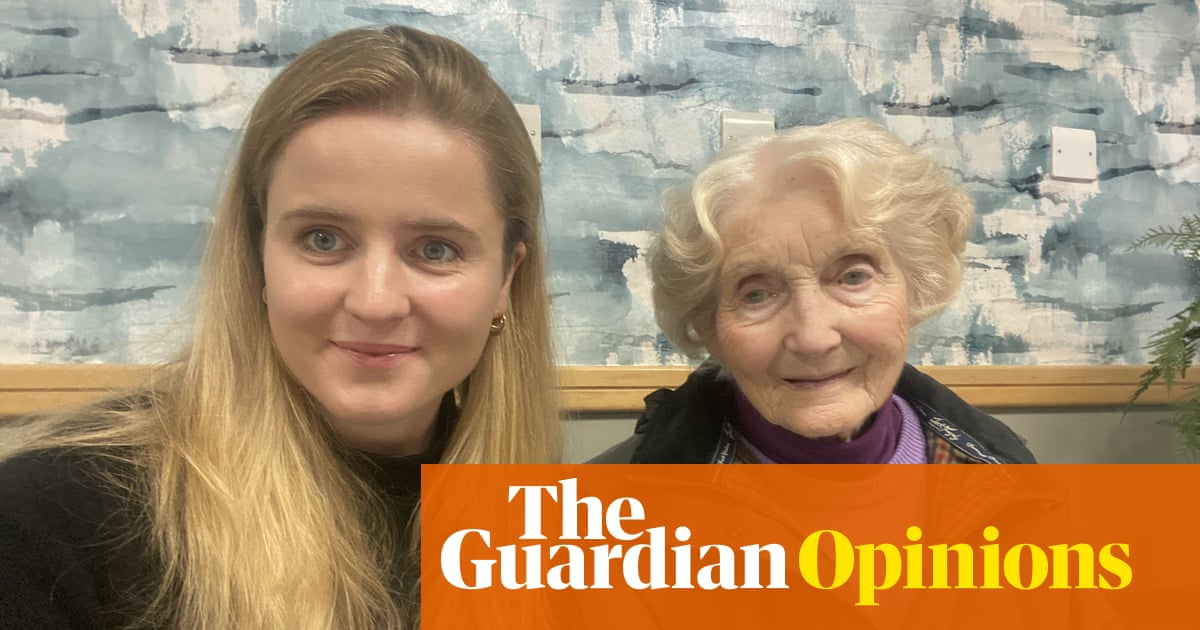
If you hadn’t walked in from a stretch of bustling city life, you’d be forgiven for thinking you were in an Alpine spa hotel. Water runs along a channel beside a lush bed of ferns in a sunny courtyard, before tinkling into a shallow pool beneath the dappled shade of mature ginkgo trees. On timber-lined walkways that wrap this tranquil space, some residents sit on benches outside their flats while others tend to herbs in the rooftop garden. The only signs of the rat race are the red double-decker buses, visible from the courtyard windows of this new almshouse in south London.
“People are so often pushed to the margins in later life,” says Martyn Craddock, chief executive of United St Saviour’s, the charity behind this handsome new block of social housing for over-65s. “We are here to provide an option for people who want to live independently in the centre of the city – and have fun in their later years.”
The word almshouse may conjure images of medieval paupers living a monastic existence, squirrelled away behind high-gated walls. But Appleby Blue, as the building is named, has been conceived as a lively social hub for its residents and the wider community. “It’s the opposite of a retreat,” says Stephen Witherford of architects Witherford Watson Mann. “The traditional almshouse was often a U-shaped courtyard of homes, with social spaces shielded away from public view at the back. We’ve turned that around and put the heart of the community right on the street.”
A huge wooden bay window projects out from the five-storey purple brick building towards the busy main road, framing a cosy space of armchairs and sofas where residents can sit and watch the world go by. “A group of us often come here with our bottles of wine on a Saturday night,” says Rob McCleary, who moved in with his wife, Sheree, in July. “It’s nice that we can see all the goings on in the street, and people wave at us from the bus. I’ve requested some treadmills too, so we can exercise with a nice view. The Shard looks amazing from here, all lit up at night.”
From the street, it makes a compelling shop window for what an enriching later life can look like. Behind the bay window are rooms for hobbies and crafts, and a large multipurpose room that plays host to film nights, yoga sessions and dance classes, designed, says Craddock, “to feel like a proper community asset and not a residents’ lounge”.
St Saviour’s, which was founded in 1541, near where Borough Market now stands, is also a grant-making trust, funding local groups for refugees, youth centres and music and arts. The idea is that these groups will make use of the new space, helping it to feel like an integral part of Bermondsey life, not a secluded retirement home.
The architecture is a radical departure from the usual older-living model of carpeted, hotel-like corridors with flats off either side. Instead, the 57 homes are accessed off broad, light-flooded walkways that circle the courtyard, sealed from the elements but designed with an outdoorsy feel. They are paved with terracotta tiles and lined with planters and chunky wooden benches that are open on one side for wheelchair access, and have wide arms to rest a cup of tea on, or to help people get up.
“In the consultation process, we asked potential residents if they wanted private balconies,” says Witherford. “But the reaction was, ‘Why would I want to sit there on my own?’” Instead, the usual planning requirement for private outdoor space has been fulfilled by making the walkways wider and more sociable than they would otherwise be. “It really helps with getting more reclusive people to join in,” says Craddock. “They might sit outside their flat and chat to their neighbour one day. Within a year they’ll be partying.”
Witherford Watson Mann, who won the Stirling prize in 2013 for their magical reinvention of the ruined Astley Castle for the Landmark Trust, have brought their acute sensitivity to context to craft a building that feels grown from its surroundings. On either side, the block extends the grain of the Victorian terraced streets, with a dignified frontage of two-storey bay windows, before stepping up towards the main road to meet the scale of the nearby postwar social housing. A monolithic sense of solidity and permanence is provided by precast concrete sills, lintels and copings, which along with the mortar are tinted purplish brown to match the Danish bricks. The brick bond is subtly varied as it rises, with projecting bricks adding depth and texture. It is the charity’s first new-build project in almost 500 years, and it looks like it’s been designed to last just as long.
Inside, the courtyard echoes the scale and form of the galleried coaching inns along Borough High Street, which were often used for Elizabethan theatre, and it creates a similarly active, social setting. You can imagine the oak-framed windows being flung open and residents declaiming soliloquies from the galleries – or, more likely, hollering to their neighbour to pop over for a cuppa. In the top-floor flats the Tudor theme continues, with chunky oak ceiling joists left exposed and quirky corner window nooks, in a welcome departure from the usual characterless white plasterboard interiors of most modern housing.
Back downstairs, a communal cooking session is under way in the big catering kitchen to celebrate the start of National Curry Week. It’s a busy scene, coordinated in part by Dr Sophia Amenyah from Bournemouth University’s ageing and dementia research centre. She and another academic will be living in the almshouse for a year, in a novel form of embedded, on-site research, monitoring the impacts of growing food, cooking and eating together on the residents’ health, wellbeing and social connectedness.
“Food is a great social leveller,” says Amenyah. “The residents have been sharing stories and recipes from their childhoods, we’ve given them cameras to document their cooking and we’re planning a food walk around Bermondsey. Living here means I can build these close personal relationships, so it doesn’t feel like I’m barging in.”
Unusually for a later-living charity, United St Saviour’s has an in-house head of research, Alison Benzimra, whose role is to initiate these kinds of partnerships and disseminate their findings beyond academic circles. “We don’t just want the research to be published in a peer-reviewed journal that only academics read,” she says. “We want it to inform and influence others in the housing and ageing sector, to really understand not only how to help people live longer, but to live well for longer.”
She recently co-authored an Almshouse Longevity Study with Bayes Business School, which found that living in an almshouse can boost a resident’s lifespan by as much as two and a half years. “The physical design of the building is a big part of it,” she says. “Even simple things like the courtyard form, meaning you come out of your front door and see your neighbour across the way, helps to tackle loneliness and social isolation.”
The fact that this remarkable place exists at all is a happy byproduct of our faustian planning system. It was built as the Section 106 affordable housing contribution in a development of luxury flats near Tate Modern called Triptych Bankside, where a pair of penthouses recently sold for £20m (not far off the £25m construction cost of the entire almshouse). Designed by Squire & Partners for Slovakian developer JTRE, it takes the form of a generic group of towers dressed in rippling bronzed panels, with flats arranged in the usual anonymous vertical silos – a place, as the marketing spiel has it, “where creativity inspires life”. The well-heeled residents can enjoy a gym, lounge, workspace, games room and private cinema. But it’s hard to imagine they’ll be having as much fun as the pensioners down the road at Appleby Blue, chatting across the courtyard and sitting with their wine in the window, watching the buses go by.











